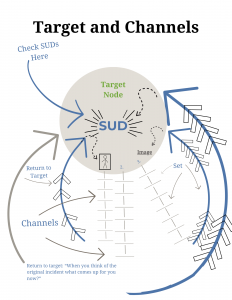Target and Channel – Checking the SUD
Target and Channels Processing Diagram
As EMDR therapists, we use the AIP model to guide our treatment approach, tailoring it to the individual needs of the client. The goal is to help clients process traumatic memories, alleviate distressing symptoms, and facilitate.
With that in mind, this is a diagram that shows how we process maladaptive life events that are stuck or frozen in the limbic brain.
The “Target Node” (in green) is the original incident or trauma memory to be processed. Ideally, it is a discrete life event that has a beginning and ending that has memories that are frozen in time. It is important to note that the memories are pictures or images, affective feelings, and body sensations, that are linked to a negative self-belief – the “memories are not just the story itself.
The little man in the box represents the original picture or image that is struck in the limbic part of the brain that stands out from the event. The line with the cross-hatches coming out of the box is the first “channel” that is traversed. The cross-hatches represent the sets. We “go back to target” when the channel plays itself out and we know when that is based on the client report. If the client reports two or three adaptive responses (often positive), then we return to the target.
So, the diagram shows going down several channels, and when the channel resolves we go back to the target. That can happen several times during a session, or even over many sessions. We play the game of going down channels and returning to the target until the target node or original incident is resolved and integrated.
Technically, we know when the target node is resolved and integrated by two things. The first is the report when asked, “When you go back to target, what comes up for you now?”- and the report is neutral or positive (adaptive). Then we do one more set, after which we ask, “What do you get?” and if that report is positive or neutral, then we check the SUD (Systematic Unit of Disturbance). From there, we go to installation. If the report is not positive or neutral that means we have headed down another channel, so we keep processing.
The important thing to note here is that we check the SUD at the target node and not at the end of the channel, which is a common error or misunderstanding.

